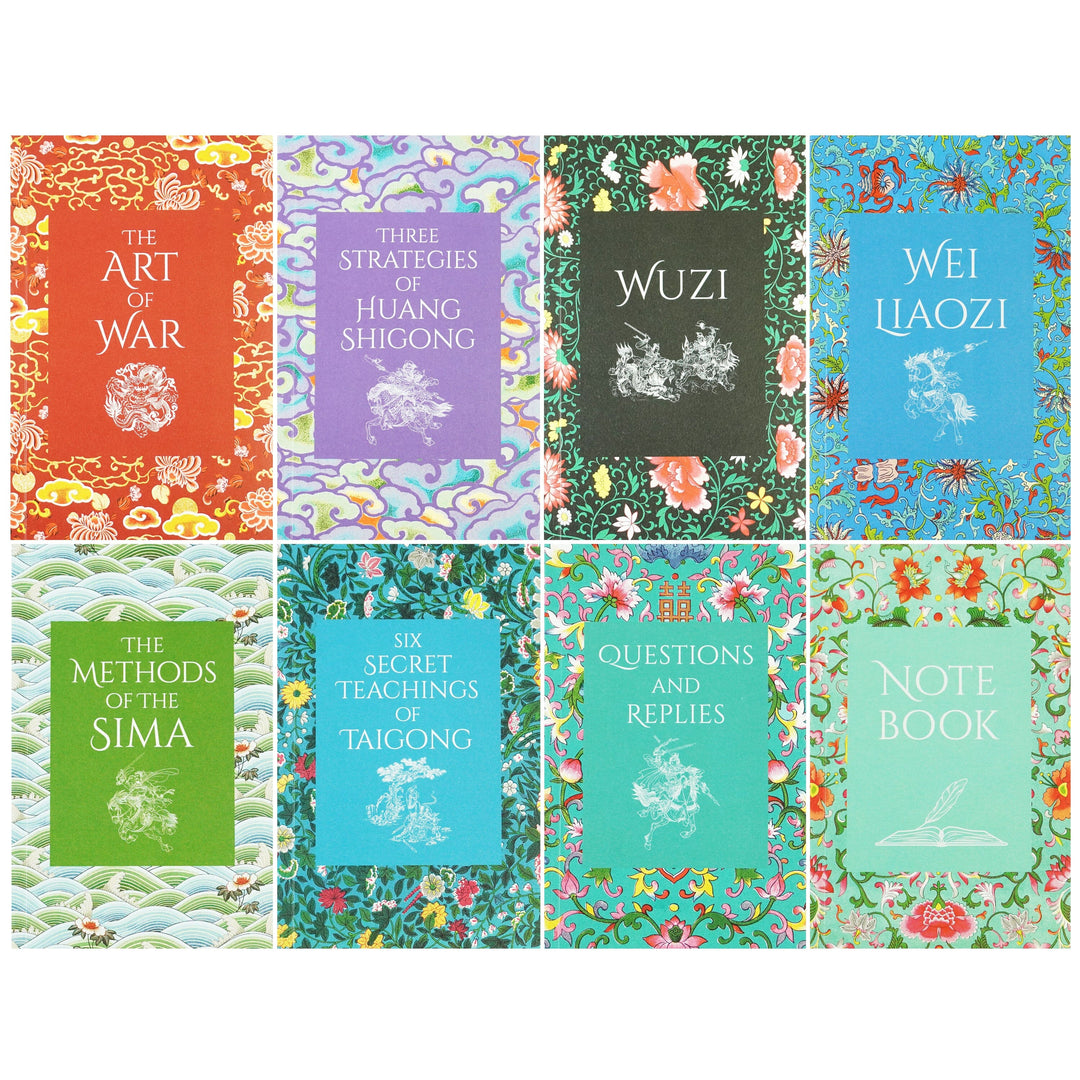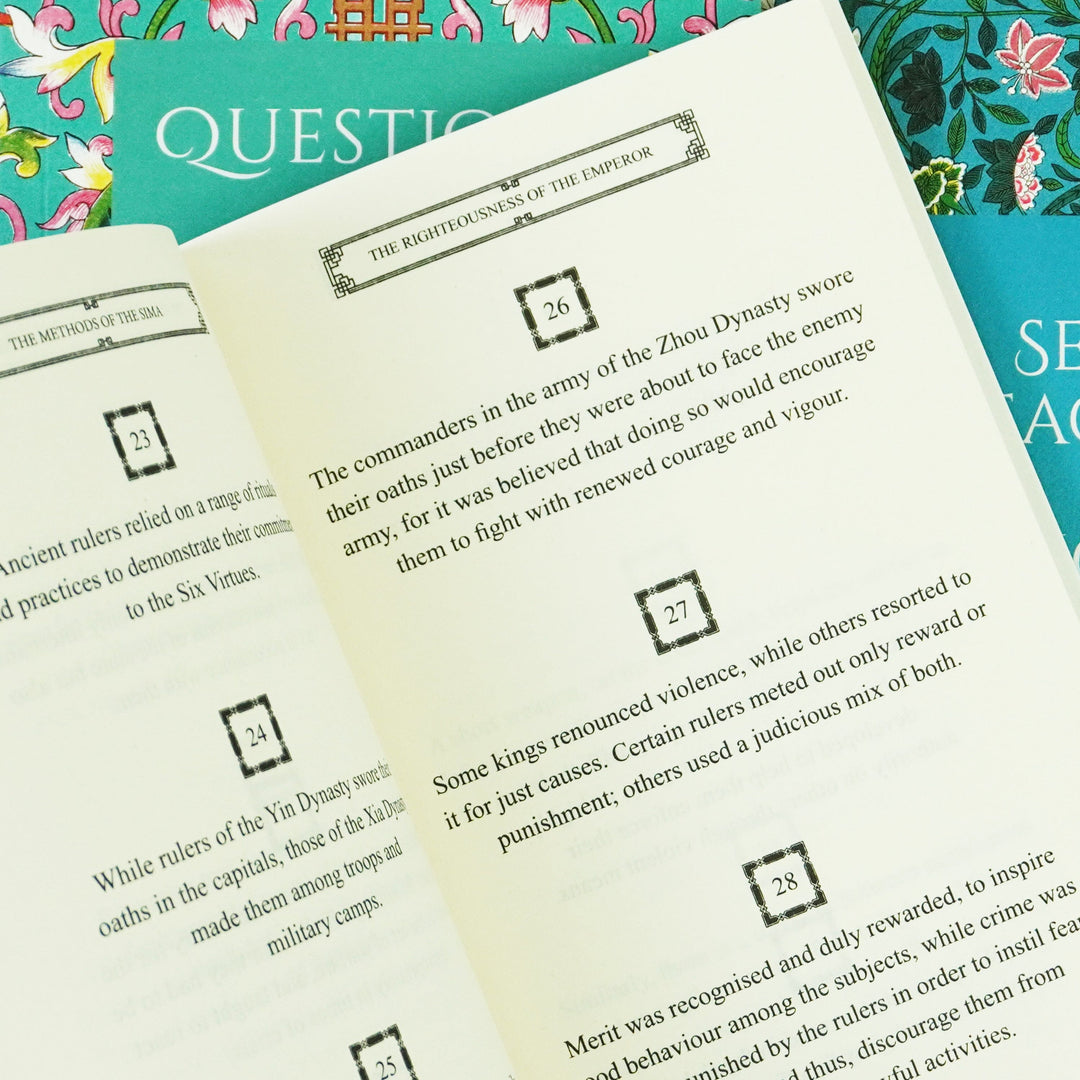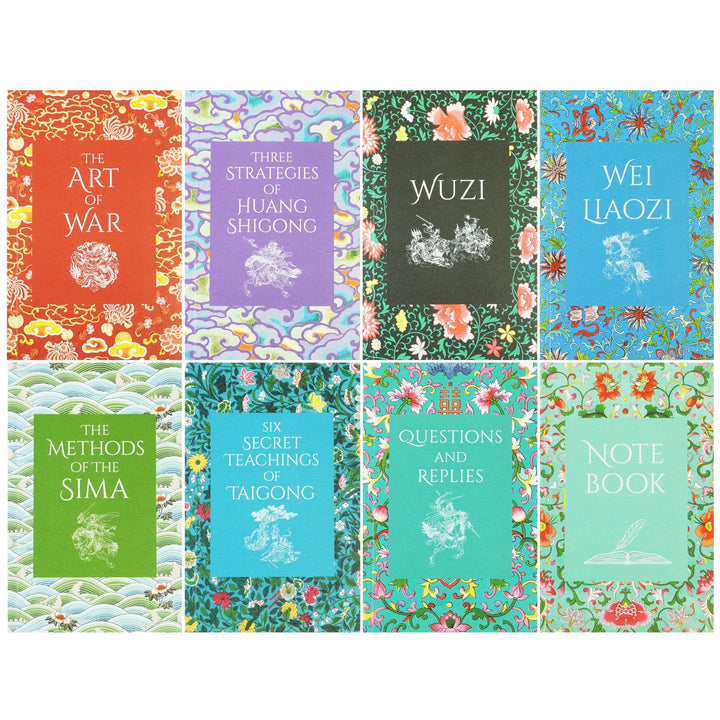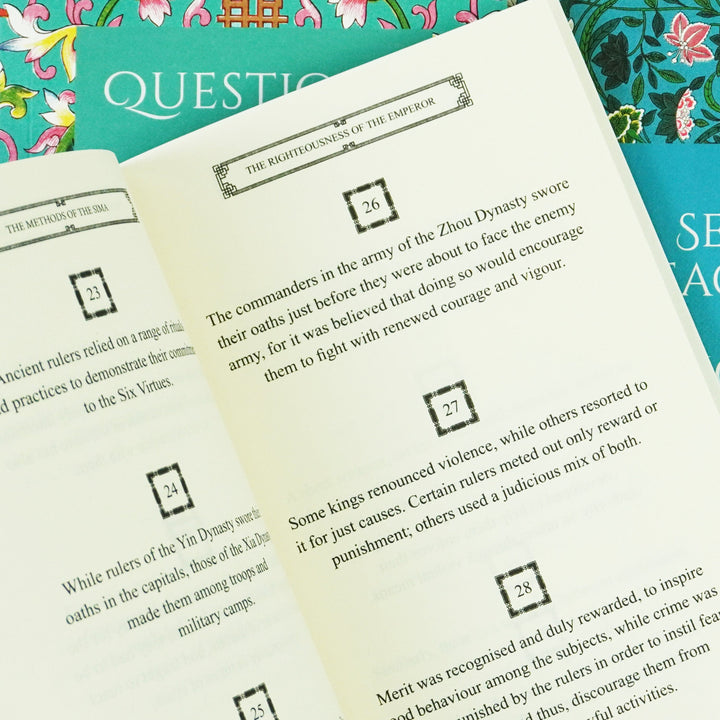The Art of War: Seven Military Classics from Ancient China 8 Books Collection Box Set - Fiction - Paperback
B2D4950
- In stock, ready to ship
- Backordered, shipping soon
Titles In The Set:
1. The Art of War
2. The Methods of The Sima
3. Wei Liaozi
4. Wuzi
5. Questions and Replies
6. Three Strategies of Huang Shigong
7. Six Secret Teachings of Taigong
8. Note Book
Description:
The Art of War
'Winning each battle is not as laudable as breaking the enemy's will to fight, without having to fight in the first place.
If you seek a window into Chinese military chinking, ancient and present, look no furcher than Sun Tzu's "The Art of War.
Thought to be compiled sometime around 500 BCE, the treatise is a succinct war manual, that ironically delves on strategies to avoid waging war in che first place. It is incisive and straight-talking. But as is typical of che Chinese mind, it is layered and subject to multiple interpretations - probably why there are many versions of this book. Sun Tzu orients warfare in complex dynamics of politics, geography, espionage and most interestingly, psychology. The fascinating part is that while he presents a set of guiding principles to wage a successful military campaign, he also lays out an equally large number of riders under which one may deviate from these dictums.
Flexibility, unpredictability and deception is after all at che heart of warfare!
The Methods of The Sima
'Handsome victories are not to be rewarded to prevent generals and the army from becoming too self-indulgent. Similarly severe losses should not result in punishment. Rather, the armed forces must be allowed time to introspect and perform better in future engagements.'
The Methods of the Sima thought to be put together around
500 BCE is designed as a reference manual for good governance.
While it does address military grand strategy and minutiae of man-management, the thrust is very much on what must a king or general do for the greater good. 'Sima's Methods* are benchmarked upon sound practices followed by ancient Sage (wise) kings who sought to order society based upon considerations of harmony, balance of power and public welfare. The breadth of thought is sweeping but the hand is light. Subtlety is a much-valued trait in Chinese culture - then and now.
Essential reading to understand the evolution of the dragon-country's strategic culture.
Wei Liaozi
If a country neither has the capability to wage war externally nor defend itself from within, then its best strategy is to develop markets.
By cultivating economic strength in this manner, the country can gradually build military competence.
Unlike other Chinese military classics Wei Liaozi questions the penchant for seeking out divine omens. The treatise does not adopt a praiseworthy tone at all times either. Kings and generals are often criticised. Common sense is emphasised
Surprisingly for a book of its vintage (around 500-200 BCE), the book talks about cannons and women in battle. It is also not shy of referencing the Art of War from time to time.
The thrust is very much on organising military and civilian affairs when war clouds loom. The martial part is pivoted around discipline and systems. Among other aspects, collective punishment is a favoured theme. The people angle is more well-rounded. Popular support for military campaigns is stated to be a pre-requisite. Don't kill che goose that lays golden eggs is the motto that China followed then and now.
Wuzi
A series of victories does not necessarily result in strategic stability.
Should victory accrue in just a single grand battle, then the kingdom has already created an empire.
The 2,500-year-old Wii is energetic reading. Scholar-general Wu Qi is part Chanakya and part Sun Tzu. He is at once sharp, detached, analytical and confident. Most importantly, his deeds match his words. The journey from advising the king on the moral basis of governance to the advantages of calculated violence seems seamless
There is compassion in cold logic and vice-versa. This approach assuages an insecure ruler, people, and soldiers at a particularly unstable point in Chinas chequered history. Wars were almost everyday occurrences, and the king was at once an administrator and near-religious figure.
The General has much the same role on the battlefield. He is a benevolent disciplinarian. He motivates his men with fervour and then follows up with concrete rewards and stern punishments. All along, he strategises and prepares to confront his many enemies
Questions and Replies
'Military planners followed The Four Kinds: "Balance of power and plans form and circumstance", "Yin and Yang", and "skill and craft".
'Sun Ten said that the pinnacle of assuming a form is to have no form.
Thought to have occurred almost 1,500 years ago, Questions and Replies Between Emperor Taizong and General Li Jing captures the changing realities of warfare at a time when the late Tang dynasty would begin its 300-year reign.
It was a world where 'Barbarians' shared an uneasy co-existence with the Han. Central Asia was both a strategic threat and opportunity. Amid such volatile times, the astute Emperor Taizong and his capable advisor General Li Jing critically evaluate ancient Chinese wisdom captured by scholars like Sun Tzu, Taigong, Wuzi, and Zhuge Liang to draw lessons for the future.
The beauty of this book is that it is at once straightforward, accessible, and yet profound. There is considerable disagreement upon the conclusions drawn by the ancients and even among the two protagonists themselves. The reader cannot help but be an energetic third participant of this timeless deliberation.
Three Strategies of Huang Shigong
"The flexible can complement the unbending. And the powerless can counterbalance the mighty. The general has utility for the wise, the brave, the greedy and also the foolish."
The Three Strategies of Huang Shigong, attributed to the Han General Zhang Liang dates back to the 3rd-2nd century BCE.
The classic publication seeks to wed military strategy with civilian administration into a meritorious and seamless whole. It has been compiled to flag lessons from history to a beleaguered era.
Of the three strategies, che Upper Strategies uphold the importance of ritual and rewards. They differentiate between the malicious and brave and distinguish success from failure.
The Middle Strategies delve into the frequent incompatibility between good intent and practice. They also probe shifts in the balance of power.
The Lower Strategies enlighten us about the Way (Tao) and virtue. They look into issues that create insecurity among people and explain the mechanics of treating deserving people and dealing with unscrupulous ones.
Six Secret Teachings of Taigong
"When held close to the ear, the pitch pipe reveals information through different sounds picked up from the enemy. These sounds can be divided into five major scales -Gong, Shang, Jiao, Zhi and Kr - corresponding to the five basic elements - Metal, Wood, Water, Fire and Earth. For example, the sound of enemy soldiers armour, will issue out as the Shang note through the pitch pipe.
Thought to be over 3,000 years old as oral tradition and compiled during the Chinese Warring States era (475-221 BCE),
Taigong's Six Secret Teachings is probably the oldest known work of Chinese military scholarship. Written with the stated objective of overthrowing the Shang dynasty (1600-1046 BCE), it insightfully combines policics and philosophy with often brutal battle tactics. It is still very relevant for military planners in that it advocates a lethal combination of subtlety and deception, with discipline and exemplary man-management. The content is presented in an easily accessible Q&A and case study format.
1. The Art of War
2. The Methods of The Sima
3. Wei Liaozi
4. Wuzi
5. Questions and Replies
6. Three Strategies of Huang Shigong
7. Six Secret Teachings of Taigong
8. Note Book
Description:
The Art of War
'Winning each battle is not as laudable as breaking the enemy's will to fight, without having to fight in the first place.
If you seek a window into Chinese military chinking, ancient and present, look no furcher than Sun Tzu's "The Art of War.
Thought to be compiled sometime around 500 BCE, the treatise is a succinct war manual, that ironically delves on strategies to avoid waging war in che first place. It is incisive and straight-talking. But as is typical of che Chinese mind, it is layered and subject to multiple interpretations - probably why there are many versions of this book. Sun Tzu orients warfare in complex dynamics of politics, geography, espionage and most interestingly, psychology. The fascinating part is that while he presents a set of guiding principles to wage a successful military campaign, he also lays out an equally large number of riders under which one may deviate from these dictums.
Flexibility, unpredictability and deception is after all at che heart of warfare!
The Methods of The Sima
'Handsome victories are not to be rewarded to prevent generals and the army from becoming too self-indulgent. Similarly severe losses should not result in punishment. Rather, the armed forces must be allowed time to introspect and perform better in future engagements.'
The Methods of the Sima thought to be put together around
500 BCE is designed as a reference manual for good governance.
While it does address military grand strategy and minutiae of man-management, the thrust is very much on what must a king or general do for the greater good. 'Sima's Methods* are benchmarked upon sound practices followed by ancient Sage (wise) kings who sought to order society based upon considerations of harmony, balance of power and public welfare. The breadth of thought is sweeping but the hand is light. Subtlety is a much-valued trait in Chinese culture - then and now.
Essential reading to understand the evolution of the dragon-country's strategic culture.
Wei Liaozi
If a country neither has the capability to wage war externally nor defend itself from within, then its best strategy is to develop markets.
By cultivating economic strength in this manner, the country can gradually build military competence.
Unlike other Chinese military classics Wei Liaozi questions the penchant for seeking out divine omens. The treatise does not adopt a praiseworthy tone at all times either. Kings and generals are often criticised. Common sense is emphasised
Surprisingly for a book of its vintage (around 500-200 BCE), the book talks about cannons and women in battle. It is also not shy of referencing the Art of War from time to time.
The thrust is very much on organising military and civilian affairs when war clouds loom. The martial part is pivoted around discipline and systems. Among other aspects, collective punishment is a favoured theme. The people angle is more well-rounded. Popular support for military campaigns is stated to be a pre-requisite. Don't kill che goose that lays golden eggs is the motto that China followed then and now.
Wuzi
A series of victories does not necessarily result in strategic stability.
Should victory accrue in just a single grand battle, then the kingdom has already created an empire.
The 2,500-year-old Wii is energetic reading. Scholar-general Wu Qi is part Chanakya and part Sun Tzu. He is at once sharp, detached, analytical and confident. Most importantly, his deeds match his words. The journey from advising the king on the moral basis of governance to the advantages of calculated violence seems seamless
There is compassion in cold logic and vice-versa. This approach assuages an insecure ruler, people, and soldiers at a particularly unstable point in Chinas chequered history. Wars were almost everyday occurrences, and the king was at once an administrator and near-religious figure.
The General has much the same role on the battlefield. He is a benevolent disciplinarian. He motivates his men with fervour and then follows up with concrete rewards and stern punishments. All along, he strategises and prepares to confront his many enemies
Questions and Replies
'Military planners followed The Four Kinds: "Balance of power and plans form and circumstance", "Yin and Yang", and "skill and craft".
'Sun Ten said that the pinnacle of assuming a form is to have no form.
Thought to have occurred almost 1,500 years ago, Questions and Replies Between Emperor Taizong and General Li Jing captures the changing realities of warfare at a time when the late Tang dynasty would begin its 300-year reign.
It was a world where 'Barbarians' shared an uneasy co-existence with the Han. Central Asia was both a strategic threat and opportunity. Amid such volatile times, the astute Emperor Taizong and his capable advisor General Li Jing critically evaluate ancient Chinese wisdom captured by scholars like Sun Tzu, Taigong, Wuzi, and Zhuge Liang to draw lessons for the future.
The beauty of this book is that it is at once straightforward, accessible, and yet profound. There is considerable disagreement upon the conclusions drawn by the ancients and even among the two protagonists themselves. The reader cannot help but be an energetic third participant of this timeless deliberation.
Three Strategies of Huang Shigong
"The flexible can complement the unbending. And the powerless can counterbalance the mighty. The general has utility for the wise, the brave, the greedy and also the foolish."
The Three Strategies of Huang Shigong, attributed to the Han General Zhang Liang dates back to the 3rd-2nd century BCE.
The classic publication seeks to wed military strategy with civilian administration into a meritorious and seamless whole. It has been compiled to flag lessons from history to a beleaguered era.
Of the three strategies, che Upper Strategies uphold the importance of ritual and rewards. They differentiate between the malicious and brave and distinguish success from failure.
The Middle Strategies delve into the frequent incompatibility between good intent and practice. They also probe shifts in the balance of power.
The Lower Strategies enlighten us about the Way (Tao) and virtue. They look into issues that create insecurity among people and explain the mechanics of treating deserving people and dealing with unscrupulous ones.
Six Secret Teachings of Taigong
"When held close to the ear, the pitch pipe reveals information through different sounds picked up from the enemy. These sounds can be divided into five major scales -Gong, Shang, Jiao, Zhi and Kr - corresponding to the five basic elements - Metal, Wood, Water, Fire and Earth. For example, the sound of enemy soldiers armour, will issue out as the Shang note through the pitch pipe.
Thought to be over 3,000 years old as oral tradition and compiled during the Chinese Warring States era (475-221 BCE),
Taigong's Six Secret Teachings is probably the oldest known work of Chinese military scholarship. Written with the stated objective of overthrowing the Shang dynasty (1600-1046 BCE), it insightfully combines policics and philosophy with often brutal battle tactics. It is still very relevant for military planners in that it advocates a lethal combination of subtlety and deception, with discipline and exemplary man-management. The content is presented in an easily accessible Q&A and case study format.
We process our orders within 24 hours. The orders go into our warehouse to be picked, packed and where appropriate consolidated into one parcel.
Our shipping times from dispatch are as follows:
Express International (2-11 business days)
Up to 2lb: $13.99
2-3lb - $17.99
3-5lb - $24.99
5-10lb - $43.99
These shipping times are the maximum shipping periods that a purchase can take to reach our customers. Shipping may be sooner than this. Please note that where applicable, customs point clearance may affect the delivery of an order and cause a delay. This is a factor that is not in our control.
Please see this page:
https://americanbookworm.com/policies/shipping-policy

















